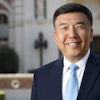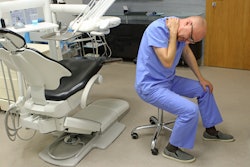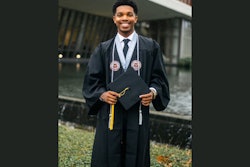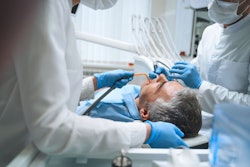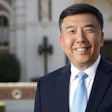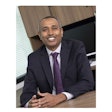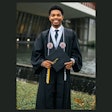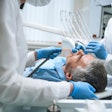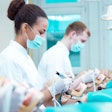For many new dentists, entering a clinic for the first time can feel like being thrown into the deep end. Years of classroom instruction and observation in dental school often leave graduates technically proficient on paper yet unprepared for the realities of patient care.
Beyond mastering procedures, young dentists must navigate patient communication, build trust, and manage complex clinical scenarios -- all difficult skills to fully develop through traditional lectures and limited hands-on experience.
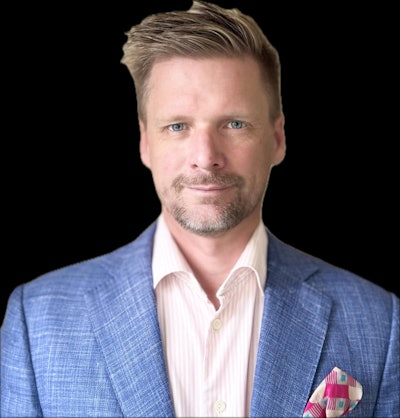 Dr. Lincoln Harris.
Dr. Lincoln Harris.
Surveys and additional feedback from dental schools show that a growing number of new dentists feel underconfident in both technical and interpersonal abilities, a gap that can negatively impact patient outcomes and professional satisfaction. For example, a young dentist who fears performing implants with bone grafting incorrectly may never feel truly confident unless they have the chance to practice in a safe environment and work through that fear of failure.
Simulation-based education is emerging as a critical solution, offering immersive, risk-free learning to bridge the gap between theory and practice. By replicating real-world procedures and patient interactions, these programs allow students to refine both their technical skills and bedside manner before they ever treat a live patient.
As dental procedures become more complex, the adoption of simulation in training programs is helping to ensure the next generation of dentists is fully prepared to deliver safe, effective, and compassionate care.
The skills gap in dental education
The traditional model of dental education, based on lectures and lab work, was built for a different era of dentistry. When Baltimore Dental College opened in 1837 as the world’s first dental school, students completed three years of training. More than 180 years later -- despite enormous advances in treatments, case complexity, and technology -- earning a dental degree still takes four years.
Today’s profession demands far more. New dentists are expected not only to deliver technically precise care but also to communicate effectively with patients, adapt quickly to emerging technologies, and manage the pressures of fast-paced clinical environments. Yet many students graduate without adequate exposure to the kinds of high-stakes scenarios they will face in practice.
This disconnect between dentists’ education and practice creates a skills gap that is felt acutely in the early years of a career, where confidence, decision-making, and patient trust are still being built. If we can’t address this skills gap, we risk perpetuating a cycle where dentists feel underprepared, patients feel underserved, and institutions struggle to keep pace with the expectations of modern care.
Advances in digital imaging, restorative materials, and minimally invasive techniques are reshaping what modern dentists must know and use in their practice at an accelerated rate. Educational programs often lag behind these innovations, leaving graduates to learn critical skills as they go; however, on-the-job training not only places pressure on new clinicians, but it creates uneven standards of care.
Addressing these issues requires a new approach to dental education -- one that equips students with both technical proficiency and adaptive, patient-centered skills needed to thrive.
A tool for continuous growth
Simulation-based education is proving to be one of the most effective ways to close the training gap. Unlike traditional methods, simulation offers standardized, repeatable, and measurable learning experiences.
Simulations allow students to practice complex procedures as many times as needed, gaining technical fluency long before they enter the clinic. They can also replicate patient interactions -- for example, rehearsing how to calm a nervous patient and build trust -- helping students strengthen the communication and problem-solving skills that textbooks cannot teach.
They can also replicate patient interactions, such as managing anxiety and explaining treatment plans, which helps students build their communication and problem-solving skills. In institutions, simulation also provides an unprecedented level of visibility into one's performance, allowing educators to track progress and tailor instructions accordingly to improve outcomes.
These benefits extend beyond the classroom and directly into the operatory. Simulation provides a safe environment for ongoing professional development, allowing experienced dentists to refine their skills, learn emerging procedures, and stay current without compromising patient safety.
Simulation-based training supports not only the education of future dentists but also the lifelong learning required to practice at the top of one’s license. By embedding simulation into both preclinical education and continuing professional development, dentistry can raise the overall standard of care while ensuring practitioners remain confident and proficient throughout their careers.
The challenges facing dental education and practice are interconnected: Technical proficiency, patient communication, and adaptability are not isolated skills, they form a composite measure of readiness for modern dentistry. Providing a structured simulation environment for both early career and experienced dentists to practice, evaluate, and refine these skills makes our workforce more capable and resilient.
Experiential learning, such as that through simulation, also reframes how the profession approaches competency itself. Rather than relying on time-based training or subjective assessment, dental education can advance toward a model that emphasizes measurable outcomes, iterative learning, and continual feedback. In doing so, schools and professional bodies can develop a dental workforce capable of navigating emerging technologies, evolving treatment protocols, and increasingly complex patient needs with precision and confidence.
The adoption of these approaches signals a fundamental evolution, one in which dentistry is prepared not just for the next patient, but for the next era of the profession itself.
Dr. Lincoln Harris is a globally recognized general dentist and the CEO of RipeGlobal. Harris has nearly 25 years of clinical experience in private practice. He has shared his insights at conferences worldwide for over two decades. In 2020, he co-founded RipeGlobal to accelerate dentists' careers and elevate practice performance. He leads the platform while managing a thriving practice and a team of over 80 dedicated professionals.
The comments and observations expressed herein do not necessarily reflect the opinions of DrBicuspid.com, nor should they be construed as an endorsement or admonishment of any particular idea, vendor, or organization.

